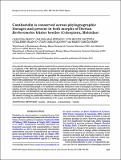Por favor, use este identificador para citar o enlazar a este item:
http://hdl.handle.net/10261/153832COMPARTIR / EXPORTAR:
 SHARE SHARE
 CORE
BASE CORE
BASE
|
|
| Visualizar otros formatos: MARC | Dublin Core | RDF | ORE | MODS | METS | DIDL | DATACITE | |

| Título: | Cantharidin is conserved across phylogeographic lineages and present in both morphs of Iberian Berberomeloe blister beetles (Coleoptera, Meloidae) |
Autor: | Bravo, Carolina CSIC ORCID; Mas-Peinado, Paloma; Bautista-Sopelana, Luis M. CSIC ORCID ; Blanco, Guillermo CSIC ORCID ; Alonso, Juan Carlos CSIC ORCID ; García-París, Mario CSIC ORCID | Palabras clave: | meloids Phylogeny toxicity |
Fecha de publicación: | 2-ago-2017 | Editor: | Oxford University Press | Citación: | Zoological Journal of the Linnean Society | Resumen: | Intra-specific coloration polymorphism coupled with an ancient process of lineage differentiation in Berberomeloe majalis (Linnaeus, 1758) offers the opportunity to analyse the temporal scenario in which the correlation between toxicity and coloration might have evolved. Based on phylogenetic and phylogeographic analyses, we identified the timing for the split between red-striped and entirely black morphotypes of B. majalis. To evaluate whether coloration patterns and toxicity are related in this species, we quantified the concentration of cantharidin across morphotypes and phylogeographic lineages. Phylogenetic analyses based on cox1 mitochondrial DNA sequences recovered three major clades where both morphotypes were intermingled, indicating a multiple homoplastic origin for the entirely black coloration. Our analyses showed that cantharidin content did not differ between morphs of B. majalis; however, it significantly increased in haemolymph in females kept isolated from males, which reveals the females’ ability either to concentrate cantharidin towards haemolymph or to synthesize cantharidin themselves. Lack of monophyly and absence of genetic isolation in both morphotypes favour the hypothesis of a recent homoplastic phenomenon to explain the loss of the striped pattern. Our phylogenetic and phylogeographic analyses show that changes in coloration are recent, suggesting that the ancient pressures that fixed and maintained red-striped colorations are no longer acting today on B. majalis. The absence of change in cantharidin content (i.e. entirely black and red-striped specimens are equally poisonous) suggests that the evolution of colour polymorphisms in B. majalis is probably decoupled from toxicity. | Versión del editor: | https://doi.org/10.1093/zoolinnean/zlw016 | URI: | http://hdl.handle.net/10261/153832 | DOI: | 10.1093/zoolinnean/zlw016 |
| Aparece en las colecciones: | (MNCN) Artículos |
Ficheros en este ítem:
| Fichero | Descripción | Tamaño | Formato | |
|---|---|---|---|---|
| Bravo ZoolJLinnSoc180 p790 2017.pdf | Artículo de investigación | 3,34 MB | Adobe PDF |  Visualizar/Abrir |
CORE Recommender
SCOPUSTM
Citations
14
checked on 12-abr-2024
WEB OF SCIENCETM
Citations
14
checked on 25-feb-2024
Page view(s)
694
checked on 22-abr-2024
Download(s)
668
checked on 22-abr-2024
Google ScholarTM
Check
Altmetric
Altmetric
NOTA: Los ítems de Digital.CSIC están protegidos por copyright, con todos los derechos reservados, a menos que se indique lo contrario.
